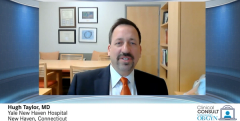
Treating Special Patient Populations With Endometriosis
An expert in reproductive endocrinology reviews endometriosis treatment options for various patient populations, including patients with infertility, endometriomas, deep endometriosis, and effects on nonreproductive organs.
Episodes in this series

Hugh Taylor, MD: There are many treatments available now. Thankfully we have some great options. The treatment landscape has expanded in the past few years, largely because of the introduction of GnRH [gonadotropin-releasing hormone] antagonists. There are many treatments available: oral contraceptives, progestins, the GnRH antagonists, the GnRH agonists, the old-fashioned danazol and androgen therapy, and surgical therapy. There are many treatment options available and shared decision-making with the patient is crucial.
Several patient populations are affected by endometriosis. One population is those patients with endometriosis-related infertility. Unfortunately, we do not have any medical therapies that improve fertility in patients with endometriosis.There is research ongoing to develop medications that will improve endometriosis-related infertility or allow us to alleviate pain while a woman is trying to get pregnant. But for infertility, women must come off the treatments for endometriosis. There are some data that pretreatment prior to an IVF [in vitro fertilization] cycle may be helpful in women with infertility as a medical therapy. We’re doing a large, randomized trial on that right now but short of in the setting of IVF, most of the things we do for endometriosis therapy cannot be used in women trying to conceive. Certainly oral contraceptives would prevent pregnancy and all the other drugs are not conducive to attempting to become pregnant. What we do traditionally is use some standard infertility treatments. We can think about using ovulation induction with intrauterine insemination. That improves pregnancy rates a bit. We can think about using IVF, which is very good at overcoming endometriosis-related infertility. Most women with infertility due to endometriosis will not be completely sterile and may be able to get pregnant without IVF. But certainly IVF gives them their highest pregnancy rate and is something you should consider if someone is a year without spontaneous pregnancy or even a shorter period for those over the age of 35 years who’ve been trying for 6 months. IVF should be part of the discussion and it may be worthwhile to have them see a reproductive endocrinologist.
Surgery is also an option. Surgery does improve fertility, but only by a small amount. It takes about 12 surgeries to get 1 pregnancy. I generally don’t recommend surgery to improve fertility. If someone’s having severe pain and wants their pain treated simultaneously with improvements in their fertility—maybe they’re in such severe pain that they can’t have intercourse and attempt to conceive—then sometimes surgery is the answer. However, the success rate per cycle of IVF is so much higher than the added improvement from a surgery that if pain is an issue, if it’s just endometriosis-related infertility, I would recommend traditional infertility therapies including IVF and referral to a reproductive endocrinologist.
In terms of patients with an endometrioma, it’s important to make sure it really is an endometrioma. That is the classic ultrasound ground-glass appearance. We can make a fairly confident diagnosis of endometrioma. If we’re not sure about the diagnosis, if it doesn’t have that classic appearance, if there are septations or fluid collections, that’s something you may really want to consider a surgical approach for to be certain that it is not a tumor or some other cystic structure. But most of the time we can tell that it’s endometrioma by that classic [ground-glass] appearance, something that’s persistent over several cycles.
It’s important to remember that the endometrioma will not necessarily shrink when you’ve suppressed the endometriosis. I use medical therapy initially for endometriomas and that may be an oral contraceptive or it may be a GnRH antagonist. The endometrioma is mostly composed of debris and old blood. That “chocolate-filled cyst” has old menstrual debris and blood. The endometriosis that’s the active grown lesion is really just the lining of that cyst wall. Even when we suppress the endometriosis—when that endometriosis itself that is the lining of that cyst wall has become dormant, inactive, fully suppressed by one of our medical therapies—the cyst fluid doesn’t go away. So I don’t expect to see shrinkage of an endometrioma and do not use that to gauge the success of my treatment. I will expect to see resolution of pain. In no one we see in endometrioma there are likely the other lesions throughout the pelvis that are probably more likely the source of the pain. Pain is probably a better indicator of the success of your treatment. Again, I don’t expect to see the endometrioma go away.
Deep endometriosis or deep infiltrating endometriosis is also more aggressive, more stubborn, more likely to be causing pain, and more severe pain. Those lesions I like to treat more aggressively. I will still start with medical therapy. These may be more likely to be resistant to progestin-based therapy. In those patients with deep endometriosis and very severe pain, sometimes I will skip an oral contraceptive and go right to a GnRH antagonist and if associated with very severe pain, in particular dyspareunia, I may even go to a higher dose of the GnRH antagonist. I think these are patients who need to be treated aggressively. When there is deep infiltrating endometriosis, it’s important that if we do progress to surgery, that that surgery will be done by deep excision. We have to be sure you’re prepared to do more aggressive surgery and be prepared for any eventuality. Those deep endometriosis cases should really only be done by those who are comfortable with that deeper section of endometriosis, full excision, rather than ablation of endometriosis.
I think we often will see effects of endometriosis on nonreproductive organs. Some of our studies have shown clear-cut effects on the brain that leads to that depression, anxiety, and pain sensitization. On weight, we know women on average with endometriosis are thinner than women without endometriosis, and there are metabolic effects that endometriosis has on the liver and on adipose tissue. Recently, we’ve shown even an effect on blood vessels and systemic inflammation. It may cause some damage in the long run. There are a lot of nonreproductive effects. Medical therapy will take care of all of the systemic effects of endometriosis rather than just the lesions in the pelvis so it’s important to get those women on medical therapy, not only to control their pain but also to control some of these nonreproductive effects. Sometimes we see actual lesions in the lung, in the brain. Cyclic hemoptysis or cyclic pneumothorax seen at the time of menses occasionally is evidence that someone has endometriosis in a nonreproductive organ. Again, before we go into surgical treatment of these nonreproductive organs, it’s always better to try this medical therapy to control this. I tend to be a little more aggressive if someone is having a pneumothorax, for example, or endometriosis in the lung than I would be for other reasons where they may have some very serious, life-threatening health complications. I may opt for more aggressive medical therapy, jumping right to a GnRH antagonist or occasionally even an agonist in somebody who wants that complete suppression and doesn’t want to take any chances with another pneumothorax after having experienced that and who may have some compromised lung function. You don’t want to risk that they’ll forget a pill or miss a treatment or otherwise be potentially exposed to another catastrophic event like that so I’m much more aggressive with therapy when I think there are lesions causing real harm to nonreproductive organs.
Transcript Edited for Clarity
Newsletter
Get the latest clinical updates, case studies, and expert commentary in obstetric and gynecologic care. Sign up now to stay informed.













